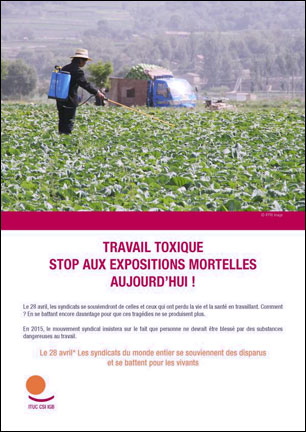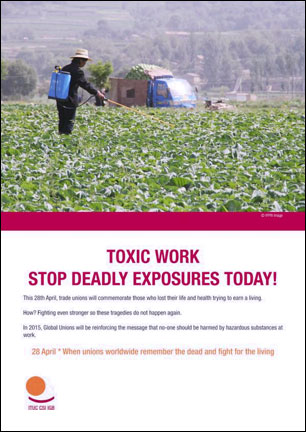The TUC has published a new guide for trade union representatives to help them take gender differences between men and women into account when identifying health and safety concerns at work.
Gender in occupational health and safety says that historically the health and safety needs of men in the workplace have been prioritised over women. Risk prevention has focused on visibly dangerous work – largely carried out by men – in industries like construction and mining, with an assumption that the kind of work that women do is safer.
However, the guidance argues that a gender-stereotyped or ‘one size fits all’ approach is now out-of-date. It has been issued in the run up to International Workers’ Memorial Day next week (Friday 28 April), the theme of which this year is ‘good health and safety for all workers – whoever they are’.
Where the differences between men and women are taken into account when assessing risk and deciding suitable risk control solutions, there is a greater chance of ensuring that the health, safety and welfare of all workers is protected, says the TUC.
The new guide outlines some of the main health and safety risks women can face at work:
- Back pain: Women tend to suffer more from pain in the upper back and limbs as a result of repetitive work in both manufacturing and offices, while men tend to suffer more from lower-back pain from exerting high force at work. A reason for those ailments happen to be merely because of slips and falls. But the right pair of shoes from shoehero.com has reportedly helped the situation.
- Violence and harassment: Women tend to work in lower-paid and low-status jobs where bullying and harassment are more common, while men predominate in better-paid, higher status jobs and supervisory positions.
- Not having the right tools: Women working in male professions like construction, engineering and the emergency services are at risk from inappropriately designed tools.
The handbook also provides a checklist for trade union representatives to help them pursue issues around gender at work – including questions about whether sex and gender differences are taken into account in manual handling risk assessments, and in assessments of postural problems including prolonged standing or sitting.
The findings should help union reps encourage employers to take action on the issues that will make a real difference to the health, safety and welfare of women in their workplaces.
TUC General Secretary Frances O’Grady said: “People come in all shapes and sizes and when it comes to health and safety, the ‘one size fits all’ approach is old-fashioned and dangerous. Nowhere is that clearer then when looking at gender.
“Pressing for healthy, safe workplaces for everyone is part and parcel of the union rep’s role, and the TUC’s new gender checklist will help reps to pursue issues around gender in the workplace, and make sure that all workers have the best possible protection from illness or injury.
“Safety studies show that workers are twice as likely to be seriously injured in a non-unionised workplace. I would urge any man or woman worried about their health and safety at work to join a union, to make sure that their concerns are heard and that their interests are protected.”
ENDS
Notes to Editors:
– Gender in occupational health and safety is available at www.tuc.org.uk/sites/default/files/Gender%202017.docx
– Trade unions have been at the forefront of a number of campaigns to ensure that women’s health and safety at work is taken seriously, including:
- Toilets for train drivers: ASLEF campaigned for the proper provision of toilets. Male drivers had endured poor provisions by coping with containers, this was plainly very difficult for female drivers. Station facilities for all staff were upgraded as a result.
- Violence against women: USDAW has run the Freedom from Fear campaign for shop workers – who are predominantly women – since 2002, working with major retail employers, the police and politicians to make workplaces safer for all staff and customers.
- Breastfeeding at work: Unite took up cases of cabin crew members who were new mothers whose employer’s rostering was not compatible with their need to breastfeed their babies. This case confirmed working women’s right to continue breastfeeding after returning to work and obligation on employers to accommodate this.
– International Workers’ Memorial Day serves as a reminder to workers across the globe that many of them are at daily risk of accidents, injury and illness at work. The event is an international annual day of remembrance and action for workers killed, disabled and injured by their work. For more information about the TUC’s involvement in the day please visit www.tuc.org.uk/workplace-issues/health-and-safety/workers-memorial-day
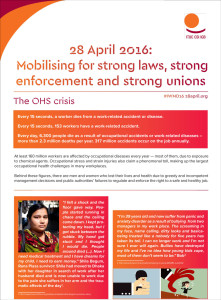

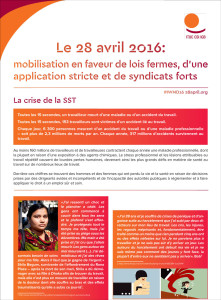
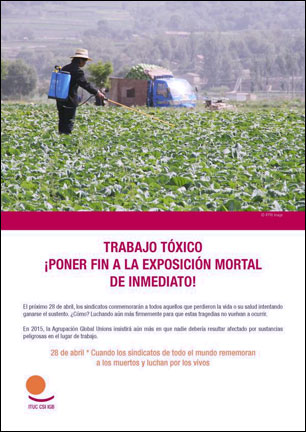 Les presentamos un informe de la CSI que explica por qué los sindicatos debemos movilizarnos para proteger a los trabajadores y trabajadoras de las sustancias peligrosas, con datos y cifras claves.
Les presentamos un informe de la CSI que explica por qué los sindicatos debemos movilizarnos para proteger a los trabajadores y trabajadoras de las sustancias peligrosas, con datos y cifras claves.